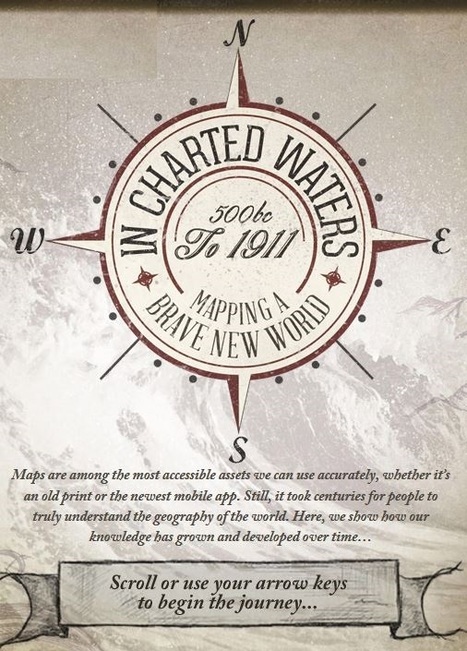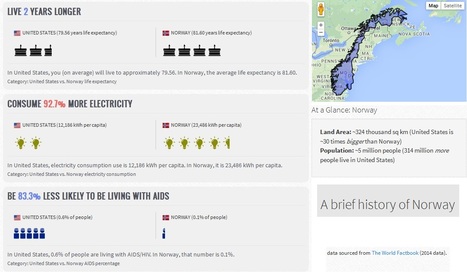"My 2015 NESTVAL presentation in an APHG session on the geography of food."
Get Started for FREE
Sign up with Facebook Sign up with X
I don't have a Facebook or a X account
 Your new post is loading... Your new post is loading...
 Your new post is loading... Your new post is loading...

asli telli's curator insight,
August 15, 2015 1:34 AM
Also applies to unfortunate Turkey w/her recent urban transformation wave...
David Stiger's curator insight,
September 12, 2018 12:24 PM
Thanks to advancements in technology and dedicated researchers who often forgo glory and fame, Americans are now aware of another impending natural disaster that is likely to ruin the lives of so many of our fellow citizens. This article reminded me of the impending doom of climate change and the resulting ecocide. So many of us, even people who put faith in religion, trust scientific discovery enough to acknowledge that these are realities we face as a society. Not all of us are totally brainwashed to dismiss this a secular, liberal hoax. Despite this awareness, not much - if anything - is being done to address or prepare for the awaiting earthquake and tsunami. This fact affirms that the United States' population is largely out-of-touch with reality. In a fantasy world, like ours, we are too special and superior (perhaps chosen by destiny or God) to suffer such a drastic and radically dreadful experience of nature. The delusion prevents us from acting sooner, rather than later. What comes to mind is the Netherlands as they train their population and renovate their urban centers to flow with the tides of climate change. They have the knowledge (like we do) but the difference is they have embraced it and in a communal way have decided to take action. These Europeans are adapting to their situation. This sheds light on the irony of the United States; a powerful, resource rich, skilled, and highly capable country that is falling a part because of what? Greed for wealth? Selfishness? Dare-I-say foolishness? Maybe it is indifference in an age of modernity - devoid of true human connection but full of technological bliss and distraction? Add the Cascadia subduction zone to modernity's doom list now including unsustainable wealth inequality, overextended military policies, climate change complacency/denial, mass incarceration, obesity, mass shootings, a post-fact world, and an Opioid health epidemic. These are BIG problems that need bold strokes. Simply put, many people with wealth and power do not feel a connection to their countrymen and countrywomen to allow a government - acting on behalf of the masses - to do something. And, that is a key link. Businesses seeking to make a profit do not want regulations and adaptation to interfere. The cost of addressing these problems is a potential loss of money-making as consumers modify their behavior and new policies require more funding through taxes. As this article relates to geography and my aforementioned class-warfare rant: the Earth is indisputably a complex planetary system that has always been totally indifferent to human wants and needs. The planet has no obligation or will to act in our best human interests. We, as a people, must respond to the planet. When it shakes, we must brace or move. In other words, we must take action or experience the consequences of inaction. Crony capitalism, excessive wealth, and a government held hostage by corporate interests which prioritize profit over people are serious hurtles. The wealthy and powerful should realize that they need US - the 90% of people that lack significant amounts of disposable income. 90% is a large chunk of civilization! There is no wealth and prosperity if there is no healthy civilization on which to build a business or exercise entrepreneurial abilities. It is time to confront greed by recognizing our collective humanity - a humanity shaped and informed by geographically determined experiences. 
Kelvis Hernandez's curator insight,
September 29, 2018 7:48 PM
An insightful and honestly, scary article. Discussing the inevitable earthquake that would devastate the pacific northwest, but not knowing when it could occur makes me never want to even visit. The Cascadia earthquake which could or more likely would send a tsunami straight into Oregon. Learning from the Seaside, Oregon superintendent that three of the four schools under his charge will go from five to fifteen feet above sea level to as much as forty-five below would shake anyone to their core. So what has the state done to remedy this? Nothing, unfortunately. With no Early-warning system, he describes how one elementary school will be trapped, as they will have no escape. With the growing ocean waters on one side and a roadless bog on the other, these students have nowhere safe to go. This reminds me of the question, would you rather know how you will die or when you will die? Waiting with no clue when the impending doom will occur until it happens is too much for me. I recommend get out now and get out quick unless the state figures out a warning system, then just get out quick. 
Corey Rogers's curator insight,
December 13, 2018 11:00 PM
Yes, we have some serious earthquakes on the San Andres fault and in Japan but we're overlooking the one along the Pacific Northwest. An out roar has to be made for people to be more notified of the Cascadia subduction zone, so people can prepare for tragedy. We need to realize that the way these plates move can make a major ripple effect on our way of life.

Kaitlyn Evans's comment,
July 30, 2015 5:24 AM
I'm not sure if I believe everything this video stated, however I think it is a good topic to analyze. I think it would be interesting to see how the rich countries became rich. They can't just have started on top. I also believe the rich countries abuse the poor countries because we can get goods/minerals/just about anything for a small price and then sell it in the rich country for much more.
Adrian Bahan (MNPS)'s curator insight,
March 14, 2016 7:49 PM
I can't say I agree with all the arguments put forward in this video, it can still be a nice starting point to get students to critically analyze the ideas put forth and assess the merits of the claims being made. |
Robert Slone's curator insight,
February 25, 2015 7:23 AM
This interactive map is phenomenal teaching tool that would be great for teaching elementary school children introductory geography, 
Samuel Meyer's curator insight,
March 23, 2015 12:00 PM
It is notable that the world's map has changed much since the advent of cartography, and many believed that the Americas were part of Asia. This is represented in the map.

Leoncio Lopez-Ocon's curator insight,
August 13, 2015 8:52 AM
Gracias a Seth Dixon accedo a este texto de acceso libre que es una interesante Introducción a la Geografía Humana. De fácil navegación se puede acceder a valiosa información textual, a imágenes, datos y otros recursos. Es un producto de Steven Graves, profesor de geografía en California State University, Northridge.
Cade Johns's curator insight,
August 16, 2015 9:26 PM
I think maps on your phone is great but what about if you get lost and you don't have service on your phone then what are you gonna do?Most young people have never had to read an actual map so most likely they won't be able to find their way back to civilization. CJ 
Ethan Conner's curator insight,
August 17, 2015 8:56 AM
Many people cannot read maps because of technolagy. This new form of maps are keeping children from the traditional way. Also keeping them from education. 
Aaron Burnette's curator insight,
August 26, 2015 9:50 AM
Although cell phone and technology is helpful, other people still believe in the prideful way. Reading paper maps.

HG Académie de Rennes's curator insight,
January 31, 2015 1:56 AM
Un site d'une grande simplicité d'utilisation bien qu'en anglais. Le principe est de choisir deux pays dans un menu déroulant pour en comparer les principaux indicateurs de développement sous la forme de petites infographies très pédagogiques. Dernière information sur ce site, les statistiques utilisées proviennent des bases de données open source de la CIA américaine. 
Brian Wilk's curator insight,
February 7, 2015 7:51 PM
After studying this comparison tool and using it to find the best of the best and worst of the worst, I picked out some highlights I'd like to share. Monaco is clearly the place to be born, earn, and live. When compared to the USA, the infant mortality rate is 71% less, the life expectancy is 10 years longer @ 84, and you'll earn 62% more money, no doubt because you have ten more years in which to do so. I believe the stats may be skewed a bit in this country comparison as the very rich live there and they have access to the best medical care, and probably don't have very many infants with them when they make the move from elsewhere, hence the low infant mortality rate. Austria is not a bad second choice as you are 33% less likely to be unemployed. On a sobering note, the life expectancy if you live in Namibia is only 52! Yikes, I'm already 53... It's far worse however in Swaziland. The life expectancy is sadly only 50.5 years and you are 44 times more likely to have AIDS than if you lived here. 26.5% of the population has AIDS! Be thankful for where you live and stop complaining, it's far worse on average in nearly all other countries. 
Monika Fleischmann's curator insight,
February 15, 2015 4:59 AM
Seth Dixon's insight:
Did you know that with 1/30th the territory of the United States, Norway still has over 25% more coastline? I didn't either until I compared Norway to the United States using My Life Elsewhere. This site is designed allow United States students to imagine how their lives might be different if they were born in a different part of the world. Students would probably die 21 years earlier if they were born in Liberia and 11 times more likely to have died in infancy. Students would be 43.8% less likely to grow up and be unemployed and have 36.3% less babies if they were born in Taiwan. This side-by-side format is a great way to help students help make these statistics real and meaningful. One major drawback: this site only allows users to compare a country to the United States. If you prefer to have students compare, say Cuba to the United Arab Emirates, I would recommend that you try If It Where My Home. |

















Things to consider when teaching about food production from a geographical perspective - remember to link to Biomes.
#Food is #geographical and #mobile...